GLAZUNOV ORCHESTRAL WORKS - NAXOS SERIES Vols 11-
15
Alexander GLAZUNOV (1865-1936)
Volumes 1-10
No other company have set about recording Glazunov's orchestral music complete.
Naxos (at bargain price again) have committed themselves to this project.
Not only is there commitment but they have already delivered fifteen volumes.
The artists vary although the orchestra, the Moscow Symphony, is a constant
through all the volumes. The conducting is shared amongst Igor Golovschin,
Alexander Anissimov (who conducts all the symphonies), Dmitri Yablonsky and
Konstantin Krimets. All the Naxos Glazunov symphonies are now available.
GLAZUNOV volume 11
Works for cello and orchestra
Concerto Ballata
Chant du Menestrel
Two Piece for Cello and Orchestra (Melodie; Serenade Espagnole)
A la mémoire de Gogol
A la mémoire d'un héros
 Alexander Rudin (cello)
Alexander Rudin (cello)
Moscow SO/Igor Golovschin
rec April 1996, Moscow
 NAXOS 8.553932
[64.29]
NAXOS 8.553932
[64.29]
Crotchet
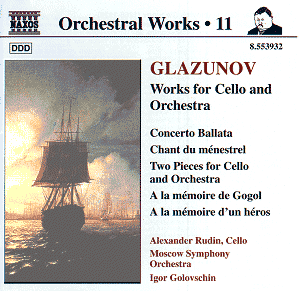
The Concerto Ballata is dedicated to Casals and was completed in 1931
the year before the saxophone concerto. It is a compact single-movement piece
running twenty minutes counterpointing sombre eloquence with a nice blast
of the old ebullience (e.g. 2.40). Its rhapsodic caste well suits Glazunov
but while it has grace it does not have the catchiness of the saxophone concerto.
The Minstrel's Song and the Serenade Espagnole are high-flown
salon pleasantries - both memorable - the former for its smooth lyrical
expression; the latter for its livelier Hispanic sentimentality. These sustained
a generation of touring cellists from 1900 onwards. The Melodie
undulates unassertively. The idiom blends Tchaikovsky (Souvenir d'un
Lieu Cher) and mid-period Miaskovsky. Alexander Rudin is well attuned
to these pieces and 'sings' them with deft subtlety.
The disc then moves on to two orchestral mementos. The Gogol (1909)
was written for the centenary of Gogol's birthday. The griping brass are
rendered impressively at 3.23. Rhapsodic and serious; tender and suave -
this is a delightful discovery so too the Hero memento. The 'hero'
is not identified but the piece is subtitled Elegie and it is that
mood that is foremost (e.g. in the mournful regret of the horn solo at 1.08).
Decent sound quality and notes.
Rob Barnett

GLAZUNOV volume
12
Symphony No. 3 (1889)
Symphony No. 9 (1910)
 Moscow SO/Alexander
Anissimov
Moscow SO/Alexander
Anissimov
rec Moscow, Feb 1997
 NAXOS 8.554253
[61.40]
NAXOS 8.554253
[61.40]
Crotchet
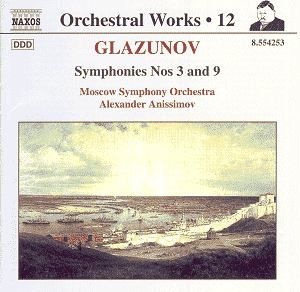
Gavril Yudin's orchestration of the first and only movement of the Ninth
Symphony has been recorded before. It seems never to have been completed
by the composer due to his superstition that writing a Ninth would signal
his death. Instead he gave the 'stub' to Maximilian Steinberg (come on Naxos
- how about the complete Steinberg symphonies?). Yudin orchestrated the movement
in 1947 and recorded it with the Moscow Radio Symphony Orchestra in the 1970s.
Anissimov's recording is about a minute longer than Yudin's on Olympia (nla).
The work is a grave superimposition of a Stokowskian Bach arrangement and
an Elgarian nobilmente (Enigma) and a Finzian weight to the
strings. I regret that Glazunov never finished this work. He seemed almost
to be striking out in new directions.
The Third Symphony is the main work and an epic one it is too running to
50 minutes. It is dedicated to Tchaikovsky and was premiered with Liadov
conducting. Keith Anderson's notes make something of the Tchaikovsky influence.
While it is there you can just as easily pick out the Rimskian and Balakirev
accents. You can also discern the skirl of Russian Easter Festival
at the end of the Symphony. More to the point all the usual Glazunov hallmarks
are there: lightning stabbing woodwind, stomping rhythmic impact and melody
welling up, Elgarian flightiness and a Mendelssohnian carefree smile playing
benevolently over the Scherzo. The performance is a minute longer than
Rozhdestvensky's deleted Olympia version. It strikes me that a tradition
of steadier tempi is developing for Glazunov (as it has for Bax who respected
Glazunov's music). The symphonies would benefit from heavier pressure on
the gas pedal. That said, the andante's Rachmaninov moments (e.g. 8.03) benefit
from the more expansive approach. At this pace a quasi-impressionist style
glides to the surface. The final allegro moderato is typically
grandiloquent and effusive with many touches we now associate with Elgar
(was Elgar influenced by Glazunov - I suspect he was and the Russian was
certainly a visitor to the UK with his symphonies heard widely in British
concert halls).
The recording is natural if mildly recessed. The whole is creditably agreeable
even if I could, ideally, have wished for a higher octane approach. Not the
zenith of the symphony series for that you need the Naxos version of the
Fourth Symphony. Do let's have no. 8 next!
Rob Barnett

GLAZUNOV
volume 13
Symphony No. 6 (1896) 35.58
The Forest (1887) 59.10
 Moscow SO/Alexander
Anissimov
Moscow SO/Alexander
Anissimov
rec Moscow July 1996, 25-26 Feb 1997
 NAXOS 8.554293
[59.10]
NAXOS 8.554293
[59.10]
Crotchet
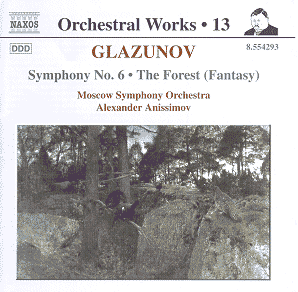
Reckoned by Rimsky-Korsakov, on its first performance, to be the highest
point in Glazunov's development, the Sixth Symphony is from Glazunov's years
of maturity. The first movement is given a cracking performance by the MSO
and Anissimov with the brass granted a saw-toothed edge and some satisfying
presence. The Brahmsian breadth of melody at 8.43 (track 1) needs more lift
and drive. Rather like Bax (himself a fan of the Russian's music) Glazunov
benefits from keeping the momentum up. The recall of Tchaikovsky 4 is palpable
in the clash of the last pages of the first movement. The theme and variations
are frankly undistinguished - not Anissimov's fault. The musette-like
Intermezzo is kin to the lighter ballet music like The Seasons.
The finale is triumphant without the angst of Tchaikovsky. Its tramping
victory may recapture the finale of Rachmaninov's First Symphony but it would
have benefited from tenser direction. The Polyansky series on Chandos also
suffers in this way. Järvi, Rozhdestvensky (Olympia) and, if I recall
correctly, from an old EMI-Melodiya LP, Fedoseyev, have a better grip. I
noted a strange bump (edit presumably) at 5.22 in the first movement.
The Forest is called a 'fantasy' but it is simply another rather good tone
poem like The Sea. The writing is inspired - strong on arboreal shadows
and shafts of sunlight. The orchestral fabric is of a satin transparency
and the themes are liquid. Works such as this laid the foundations for French
impressionism and for the works of Delius and Bax (Nympholept and
Happy Forest). This is, at the same time, one of the composer's most
nationalistic works (Borodin and Rimsky hallmarks).
Decent notes by Marco Polo/Naxos stalwart, Keith Anderson, whose name has
graced their releases since their entry in the lists in the early 1980s on
LP.
A decent entry in the Naxos Glazunov series (vol. 13) - strong for The
Forest and the first movement of the symphony.
Rob Barnett

GLAZUNOV Volume
14
Piano Concerto No. 1 (1910) [34.22]
Piano Concerto No. 2 (1917) [21.03]
Variations on a Russian Theme (1901) for orchestra by
Artsybushev, Vitols, Liadov, Rimsky-Korsakov, Sokolov, Glazunov.
[13.30]
 Oxana Yablonskaya (piano)
concertos only
Oxana Yablonskaya (piano)
concertos only
Moscow SO/Dmitry Yablonsky
rec Moscow 18-23 June 1996
 NAXOS 8.553928
[69.01]
NAXOS 8.553928
[69.01]
Crotchet
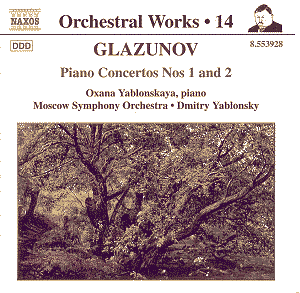
The Naxos series promises to be a definitively exhaustive traversal of the
Glazunov catalogue if the inclusion of these Variations is anything to go
by. A composite work with a last movement finding Glazunov's affinities with
Brahms' Academic Festival Overture it is a pleasing oddity and good
to have. A quick rundown on the movements: Artsybushev: a cheery little march;
Vitols: Borodin-like as in the overture to Prince Igor; Liadov: bright
effervescence; Rimsky: buoyant confidence like the march from Golden
Cockerel; Sokolov: affecting and magical song (I want to hear more by
Sokolov!).
The two piano concertos date from after the stump of the Ninth Symphony -
latish works. The first is lovingly paced and cradled by Yablonskaya (the
conductor's mother). It flows like a nocturnal river. Its inflections are
frequently of a Rachmaninovian caste with the influence of Tchaikovsky also
in evidence. Glazunov in the first movement is rather pleasantly discursive
and relaxed in the diffuse second movement.
The compact second concerto is fifteen minutes shorter than the first concerto.
It is in a single movement and overall works better than the garrulous first
concerto. Its Chopin-like filigree has a decorative fragrance and appeal
familiar from the Scriabin concerto though without the endurance and sheer
memorability of the Scriabin work or, for that matter, the Arensky Piano
Concerto. Do not expect the mordant tempest and passion of the Tchaikovsky.
At its price the disc has no competition. There is no similar coupling at
any price although the two concertos are coupled on Hyperion with a work
by Goedicke.
Rob Barnett

GLAZUNOV
Volume
15
Symphony No 5 [35.05]
Symphony No 8 [42.52]
 Moscow SO/Alexander
Anissimov
Moscow SO/Alexander
Anissimov
rec Moscow Jan 1997
 NAXOS 8.553660
[78.07]
NAXOS 8.553660
[78.07]
Crotchet
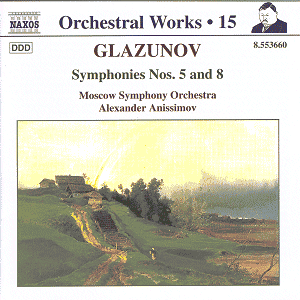
This is simply the best of the Naxos Glazunov symphony series.
That the two works run together to 78.07 also makes the disc a winner. The
symphonies have not been consistently successful in the Naxos series but
these two are very good indeed. They certainly rate with Anissimov's cracking
version of the Fourth Symphony.
The Fifth is the most popular of the cycle. Its first movement starts with
a slow mournful meditation on the main theme before rushing forward with
a long-breathed theme of great staying power (3.03 onwards). The woodwind
of the MSO deserve special mention for their brilliance and character which
is also much in evidence in the Scherzo (Glazunov is always good at these).
Speaking of which, the terpsichorean Scherzo develops a confident romantic
climax. The andante is decidedly Sibelian at times while the celebrations
of the Allegro Maestoso are topped off by some restless brass orations and
goaded on by superb work by the clarinets and flutes.
The Eighth Symphony opens with a theme which Prokofiev might well have
unconsciously had in mind when he wrote the great romantic theme for the
finale of his Seventh Symphony. That first movement has an Elgarian undercurrent
- also evident in the finale. The grim Mesto has its Götterdämmerung
moments and even the rather starved figure in the scherzo is shaken with
a stealthy sense of conflict. The finale develops along the lines of a fugal
paean riven by Tchaikovskian echoes (Symphony No. 5). Golovschin could have
afforded to have goaded the orchestra along at a tarter pace but the overall
effect is still one of ambition achieved - a confident Imperial splendour.
This is the crown of the Naxos series. It remains to be heard what Polyansky
will make of it when Chandos reach No. 8. Certainly he is outpointed
by Golovschin in No. 5. Rozhdestvensky still has much to tell us about both
works on Olympia (if you can find the discs) and if you still have the Konstantin
Ivanov conducted LPs of these two works on EMI-Melodiya don't trade them
in just yet. Anyway back to practicalities: this is a prize disc at any price.
Wholeheartedly commended.
Rob Barnett

NOTE: yet to come in this series are the concertos for Saxophone and Violin
(according to an old copy of Grove there are two - one in A minor and one
in A Major Opp 73 and 82 respectively - first I've heard of an A major work).
There are couples of overtures on Greek Themes and Serenades not to mention
an Oriental Rhapsody. A Paraphrase on the National Anthems of the Allies,
a March on a Russian Theme, Chopiniana, and Triumphal March for the Chicago
Exhibition. Now if you move onwards to the works for chorus and orchestra
there is a Coronation Cantata (done by Chandos - I have not heard this),
Memorial Cantata, and Song of the Volga Boatmen. RB
